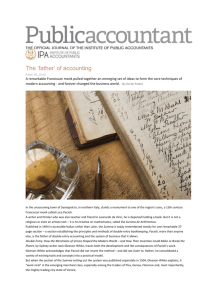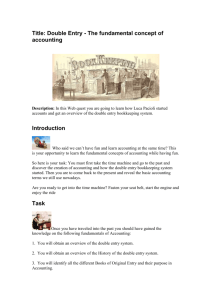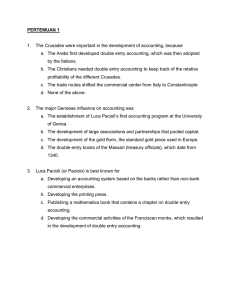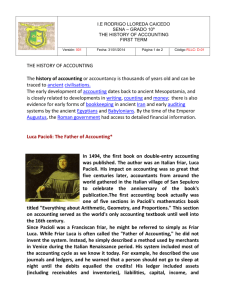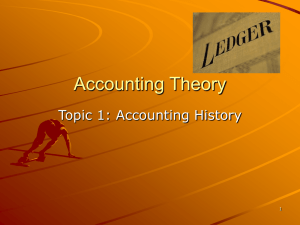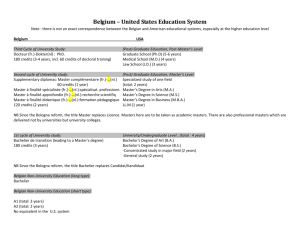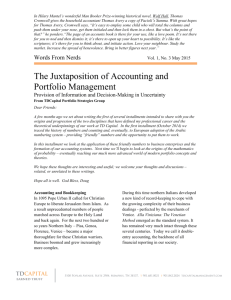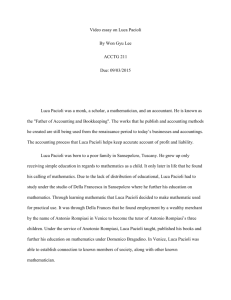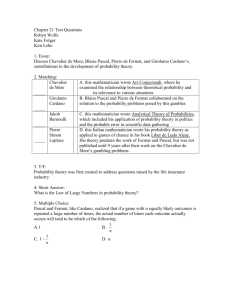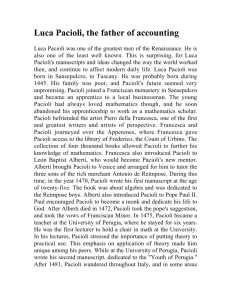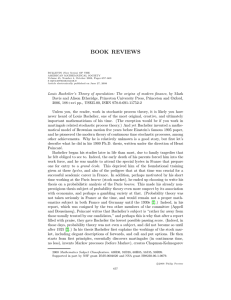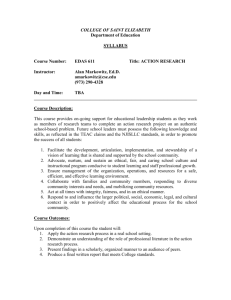Read more of Words from Nerds Vol. 1, No. 4
advertisement
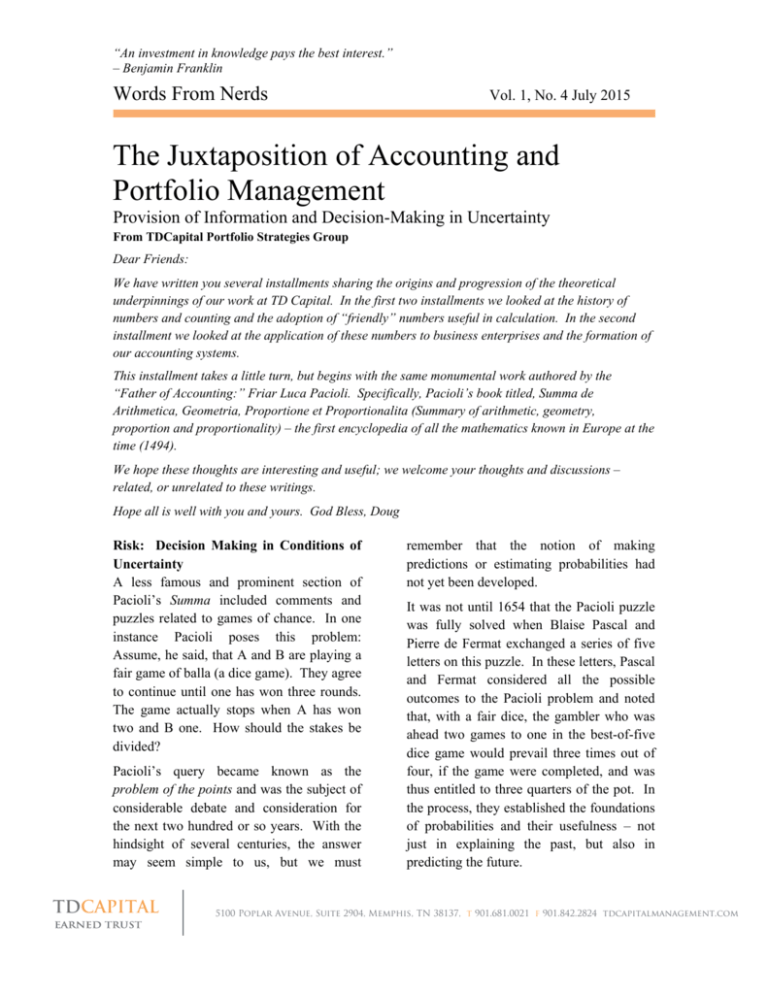
“An investment in knowledge pays the best interest.” – Benjamin Franklin Words From Nerds Vol. 1, No. 4 July 2015 The Juxtaposition of Accounting and Portfolio Management Provision of Information and Decision-Making in Uncertainty From TDCapital Portfolio Strategies Group Dear Friends: We have written you several installments sharing the origins and progression of the theoretical underpinnings of our work at TD Capital. In the first two installments we looked at the history of numbers and counting and the adoption of “friendly” numbers useful in calculation. In the second installment we looked at the application of these numbers to business enterprises and the formation of our accounting systems. This installment takes a little turn, but begins with the same monumental work authored by the “Father of Accounting:” Friar Luca Pacioli. Specifically, Pacioli’s book titled, Summa de Arithmetica, Geometria, Proportione et Proportionalita (Summary of arithmetic, geometry, proportion and proportionality) – the first encyclopedia of all the mathematics known in Europe at the time (1494). We hope these thoughts are interesting and useful; we welcome your thoughts and discussions – related, or unrelated to these writings. Hope all is well with you and yours. God Bless, Doug Risk: Decision Making in Conditions of Uncertainty A less famous and prominent section of Pacioli’s Summa included comments and puzzles related to games of chance. In one instance Pacioli poses this problem: Assume, he said, that A and B are playing a fair game of balla (a dice game). They agree to continue until one has won three rounds. The game actually stops when A has won two and B one. How should the stakes be divided? Pacioli’s query became known as the problem of the points and was the subject of considerable debate and consideration for the next two hundred or so years. With the hindsight of several centuries, the answer may seem simple to us, but we must remember that the notion of making predictions or estimating probabilities had not yet been developed. It was not until 1654 that the Pacioli puzzle was fully solved when Blaise Pascal and Pierre de Fermat exchanged a series of five letters on this puzzle. In these letters, Pascal and Fermat considered all the possible outcomes to the Pacioli problem and noted that, with a fair dice, the gambler who was ahead two games to one in the best-of-five dice game would prevail three times out of four, if the game were completed, and was thus entitled to three quarters of the pot. In the process, they established the foundations of probabilities and their usefulness – not just in explaining the past, but also in predicting the future. TDCAPITAL 5100 Poplar Avenue, Suite 2904, Memphis, TN 38137, t 901.681.0021 f 901.842.2824 tdcapitalmanagement.com Peter Bernstein’s 1996 book, Against the Gods: The Remarkable Story of Risk, traces the history of further advances following the Pascal and Fermat studies in great detail. A summary moving from the 17th century to the beginning of the 20th includes: 1711 – Jacob Bernoulli introduces the “law of large numbers,” providing the basis for sampling from large populations. 1738 – de Moivre derives the normal distribution (bell curve) furthering the usefulness of samplebased probabilities. Gauss and Laplace refine this work. 1763 – Reverend Thomas Bayes publishes his treatise on how to update prior beliefs as new information is acquired – Bayes Theorem. 1800’s – Insurance business develops and with it comes actuarial measures of risk, based upon historical data. At the turn of the last century, in his 1900 doctoral thesis at Paris’ Sorbonne, Louis Bachelier combined some of the discoveries noted above with others’ scientific observations into a theory of speculation based on data supplied via the Paris stock exchange. Bachelier’s work was not well received by academia – he was awarded a grade only of “honorable” and was essentially blackballed from the highest levels of academics. Bachelier’s work resurfaced around 1950 with studies conducted by a student at the University of Chicago named Harry Markowitz. Markowitz studied Economics under Milton Friedman and others but, like Bachelier, his work on the stock market and finance was also not initially well received by Economics Academics. Markowitz’ work formed the basis for what is now known as Modern Portfolio Theory – defining the “good” dimension of portfolios as the expected return on investment and the “bad” dimension as the variance or volatility in that return. Hence defining risk as variance from expectations, or volatility along the road. This work is designed to tell us how to construct portfolios and touts diversification as a major tool of risk management. Value Investing / Benjamin Graham At about the same time (early 20th century) that Bachelier was developing his thesis, the access to and the reliability of financial reports from corporations improved. Analysts began to construct risk measures, or decision models based on accounting numbers. Ratios of profitability and financial leverage (e.g. price-earnings; debt to equity) were used to measure risk. By 1915, services including the precursor to Standard and Poor’s, Fitch and Moody’s processed accounting information to provide bond ratings as measures of credit risk in companies. Benjamin Graham, Warren Buffet’s teacher at Columbia, in his first edition of Security Analysis in 1934, argued against measures of risk based on past prices (such as volatility or variance and in contrast to the work of Bachelier and Markowitz) and suggested that risk comes rather from paying too high a price for a security, relative to its value. Much of his teachings and writings involve how to measure this “value” from the data and information contained in financial reports and accounting information, much as described in the 15th century by Friar Luca. Although Graham’s work helps determine which stocks to own, he doesn’t give much consideration to total portfolios. Today Our 17th century letter writers and puzzle solvers’ - Fermat and Pascal - solution to Pacioli’s query continues to influence decision-making in circumstances of uncertainty. The work of Bachelier and Markowitz has expanded greatly and continues – portfolios have become very complex. The analysis of financial information provided by accounting records becomes more and more sophisticated. However, precision in predicting the future remains elusive. It seems that every time we think we have it figured out the gods intervene and send us back to work. In October 1987 the stock markets crashed. Not because of inadequate financial reporting; and not suggesting that some principal of forecasting failed, or that diversification is a bad idea. Rather, the problem was endogenous, i.e. resulting from practices like portfolio insurance and dynamic hedging. In 1998 a huge hedge fund called Long-Term Capital Management nearly brought the world financial market to its knees. Again endogenous - artificial risk reduction techniques failed. And surrounding 2008 we experienced a “great recession” caused primarily by actions, once again, in and around the financial system – sliced and diced mortgage-backed securities, liar loans, derivatives, and so on. Work in this area (known as endogenous risk), coming principally out of the London School of Economics, is exciting and promising. Accounting standards are rapidly moving from a country to country perspective as International Financial Reporting Standards (IFRS) are adopted by the U.S. and other major companies. Analysis will take on new challenges as these standards and formats are adopted. John Bogle (Vanguard founder) and others are writing and talking about the clash of cultures between speculators and investors – both operating within the same financial markets. So the burden remains and our work continues. Whether the information decision makers seek is related to investing, engineering, medicine and healthcare, our environment, or many other topics, the synthesis of accurate, complete, orderly information with the development of theoretical frameworks to process the information and improve our predictive powers will continue. We close with thoughts from Hilary Mantel’s wonderful Man Booker Prizewinning historical novel, Wolf Hall. Thomas Cromwell gives the household accountant Thomas Avery a copy of Pacioli’s Summa. With great hopes for Thomas Avery, Cromwell says, “It’s easy to employ some child who will total the columns and push them under your nose, get them initialed and then lock them in a chest. But what’s the point of that?” he ponders. “The page of an accounts book is there for your use, like a love poem. It’s not there for you to nod and then dismiss it; it’s there to open up your heart to possibility. It’s like the scriptures; it’s there for you to think about, and initiate action. Love your neighbour. Study the market. Increase the spread of benevolence. Bring in better figures next year.” This article may contain some forward looking statements. There can be no guarantee that any forward looking statement will be realized. Past performance does not predict or guarantee future returns. Investing involves risk, including loss of principal.
